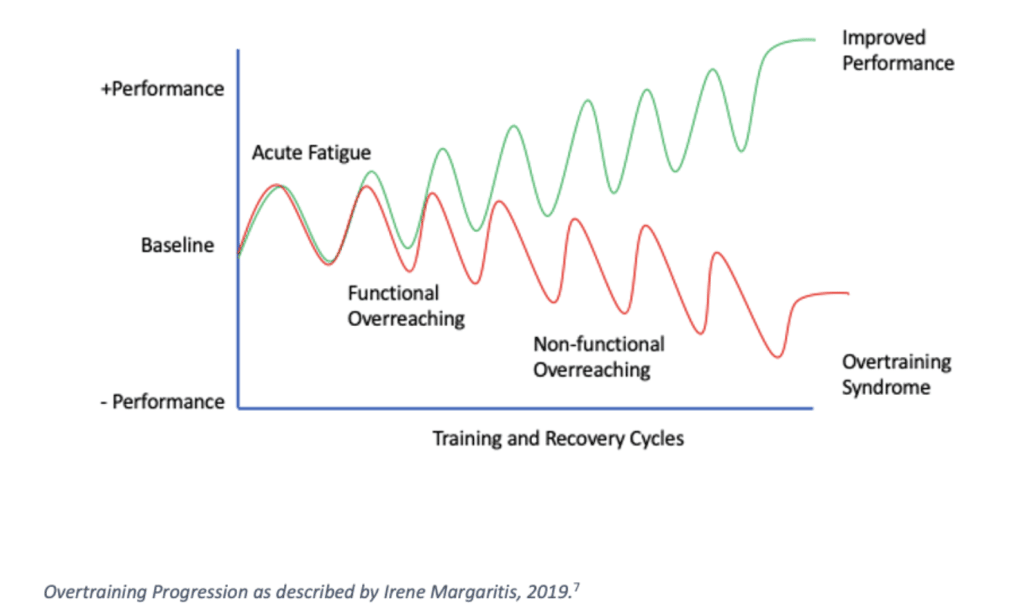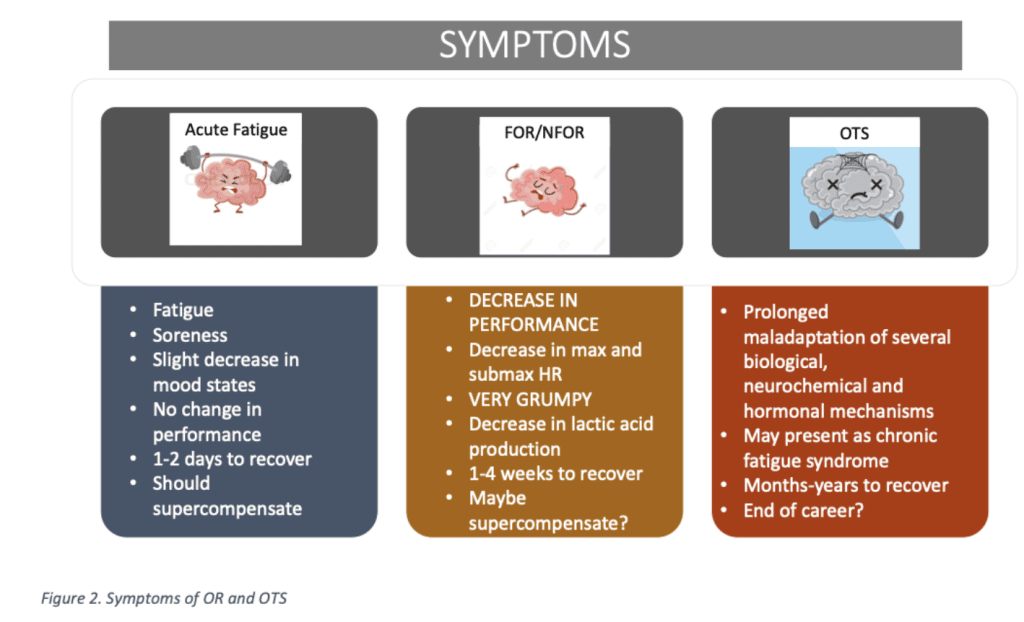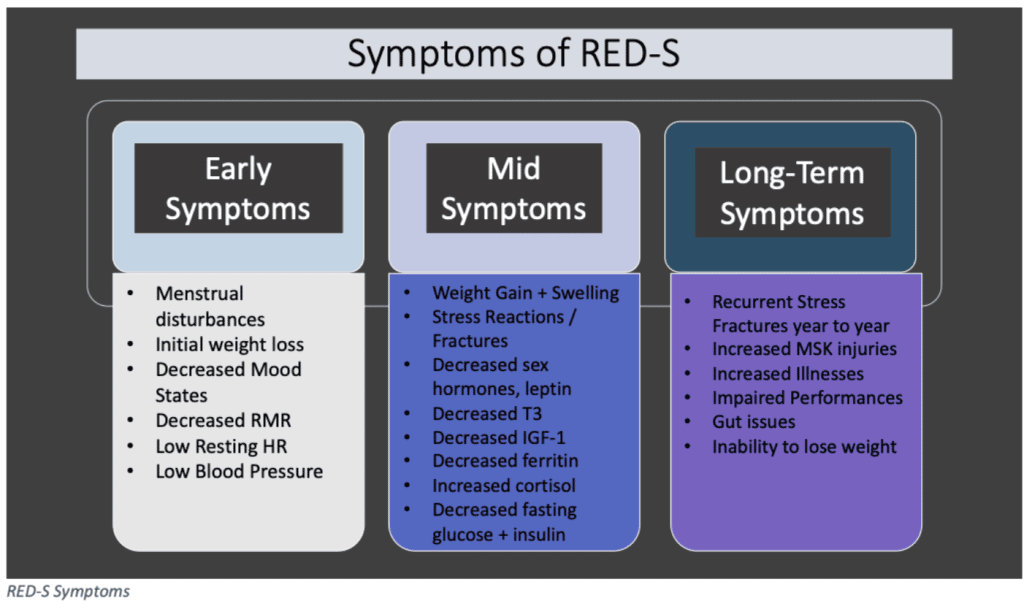Overtraining syndrome is a serious situation and it is critical to understand it and to know the signs and symptoms. Expert contributor Alexandra Coates covers this topic in depth.

This blog post is largely taken from our certification content and is contributed by UESCA advisor, physiologist and overtraining syndrome expert Alexandra Coates.
While everyone has heard of the terms “Overtraining” and “Overtraining Syndrome”, there is a lot of confusion as to what overtraining really is. In this section we will define the components of the overtraining spectrum and touch on how relative-energy deficiency in sport may drive underperformance. To begin, “overtraining” is defined as the verb to describe the process of intensified training that could lead to “acute fatigue”, “overreaching”, or “overtraining syndrome”. Therefore, overtraining can be used interchangeably with “overload” training.
Acute Fatigue
It is well understood that a certain amount of overload training is required for training adaptation to occur. As training load is increased, the athlete should experience normal training fatigue, which is called acute fatigue. Acute fatigue should last a day or two upon recovery, and then there should be a micro-adaptation or supercompensation.
Functional Overreaching
Functional overreaching is different from acute fatigue primarily because there is a decrease in performance. While acutely fatigued athletes may feel tired, they are still able to perform if they are required to, whereas functionally overreached athletes are unable to perform to their normal abilities. This typically occurs following a two-to-three-week training camp or a particularly hard block of training.
Functional overreaching takes about 1-2 weeks to recover from, but symptoms should resolve completely following appropriate rest. If adequate recovery is taken, there may be a performance super-compensation, or there may just be a return to the athlete’s baseline level of performance (1-5). Eliciting acute fatigue with training has been shown to be a more reliable method of achieving super-compensation than functional overreaching (1), which suggests that overreaching is not required or even recommended for performance gains.

Non-Functional Overreaching
Non-functional overreaching occurs when athletes are not given sufficient recovery time following functional overreaching. Non-functional overreaching is different from functional overreaching simply because it takes weeks-to-months to recover from this state (once the athlete take time off), and the athlete will lose fitness due to the lengthy recovery period. Athletes may have a difficult time determining whether they are having symptoms of overreaching or whether they are simply unfit, which can be extremely frustrating. Non-functional overreaching should be avoided, and if an athlete is suspected of having non-functional overreaching, months of recovery may be required.
Overtraining Syndrome
Lastly there is Overtraining Syndrome (OTS). The literature suggests that the occurrence of overtraining syndrome may not be as simple as training through a state of non-functional overreaching, as it likely requires some additional factors or circumstances in addition to training-stress for the syndrome to be initiated (6). The reason it is believed that OTS may require additional factors is simply because most athletes have likely experienced some form of overreaching, but only a very small percentage of athletes ever develop true OTS (6). The triggers of OTS are incompletely understood, but there may be a triggering virus, gastrointestinal issue, or excessive altitude/heat training stress which may predispose the athlete towards developing OTS. The definition of OTS is the “prolonged maladaptation of not only the athlete, but several biological, neurochemical and hormonal regulation mechanisms” (6), and requires the exclusion of any other disease, nutrient deficiency, or other major disorders (6). The literature suggests that it takes months to years to recover from OTS and often spells the end of the athlete’s career (6). As these athletes seem to be particularly sensitive to training and life stress for many years afterwards, most athletes do not return to high performance sport following a diagnosis of OTS.
RED-S
Relative Energy Deficiency in Sport (RED-S) is not on the overtraining spectrum but does share a number of common symptoms to overreaching. RED-S (7) is a progression of the Female Athlete Triad (8), which is the understanding that insufficient energy availability (i.e., not enough calories eaten compared to those expended) leads to a decrease in reproductive hormones which disrupts the menstrual cycle, and which causes low bone mineral density leading to stress fractures (8). RED-S builds upon this model by suggesting that low energy availability can cause a host of other physiological symptoms, can drive underperformance, and is not restricted to female athletes. RED-S and overreaching may overlap as it is very difficult to assess calories in vs. calories out with accuracy, and athletes may be training so hard that they are inadvertently in a state of low-energy availability. Further, research hasn’t been able to conclusively show that overreached athletes aren’t underperforming simply because of an energy deficiency (9). However, while RED-S can be detected with standard blood tests, overreaching and overtraining syndrome rarely are identified with blood markers (10). As such, while there is without a doubt some overlap between RED-S and overtraining, there are also some differences which we will see in the symptoms section below.
Symptoms of RED-S
To begin, mood states follow an inverse linear trend with training load, so as training load increases, the athlete will become more irritable and emotionally unstable. A state of acute fatigue should feel like normal training fatigue, whereas athletes who are overreached will show more symptoms of depression and anxiety. Overreaching (functional and non-functional) is further characterized by a decrease in heart rate at exercise intensities over ~70% of max (not just at max), and a decrease in lactic acid production (1, 11) – resulting in the athlete not being able to sprint or push hard. Functionally overreached athletes also have increased sympathetic nerve activity, reduced maximal cardiac outputs, and increased arterial stiffness (3, 4). While coaches and athletes will not be able to detect all of these symptoms in training, they should be able to recognize underperformance in training, and that training feels much harder than it should. If you are using heart rate measures, heart rate recovery will be faster following a given effort (take HRR as the difference in HR at the end of exercise to 60sec post-exercise while the athlete is standing/sitting still). Waking heart rate variability may be higher or lower with overreaching but will likely be different from baseline (5). There isn’t a resting blood marker that accurately predicts overreaching or OTS.

Overtraining Syndrome symptoms are harder to pinpoint because due to the maladaptation of several physiological axes, there are a variety of symptoms individual to the athlete (12). Most athletes with OTS report extreme exhaustion, deep muscle and joint pain following even easy exercise, and strange disturbances to heart rate. Often these heart rate disturbances present as highly elevated heart rates during easy exercise, and a potential suppression of heart rate during hard exercise. Sleeping disturbances seem to be common with racing heart rates or anxiety that does not allow for sleep, or in extreme cases, athletes cannot stop sleeping. Athletes also report extreme brain fog, difficulty concentrating, anxiety, and depression. There are many more symptoms that likely represent the individual imbalances, however standard blood test results are usually normal (10). Altogether, these symptoms are very similar to that of chronic fatigue syndrome.
Finally, RED-S is the easiest to diagnose as we have some clear symptoms and blood markers. The earliest marker of RED-S is a suppression to resting metabolic rate, which means athletes with RED-S often gain weight rather than lose it, despite taking in less calories than they expend. There will be reductions to blood pressure and resting heart rate. In a standard blood test, there will be a combination of red flags such as low estrogen, testosterone, luteinizing hormone, follicle-stimulating hormone, T3, IGF-1, serum ferritin, leptin, fasting blood glucose and insulin, and increased LDL cholesterol and cortisol (8, 13-15). Finally, after a long period of RED-S, athletes will have reduced bone mineral density which will likely result in stress reactions or stress fractures (7).

In the video below, Alexandra Coates discusses many of the above areas in greater depth.
Rick Prince is the founder of United Endurance Sports Coaching Academy (UESCA), a science-based endurance sports education company. UESCA educates and certifies running, ultrarunning, cycling and triathlon coaches (nutrition coming soon!) worldwide on a 100% online platform.
Alexandra Coates is an exercise physiology PhD candidate at the University of Guelph, ON Canada. She is a triathlon coach and a retired elite ITU triathlete. She has published articles in the areas of overtraining and overreaching, Relative Energy Deficiency in Sport, iron deficiency and anemia in athletes, and exercise-induced cardiac fatigue. In her professional triathlon career, she won the 2015 elite national championships, placing top 5 in a handful of continental and Pan American Cup races, and made two U23-elite World Championship teams.
- Aubry A, Hausswirth C, Louis J, Coutts AJ, Le Meur Y. Functional overreaching: The key to peak performance during the taper? Med Sci Sports Exerc. 2014;46(9):1769-1777. doi:10.1249/MSS.0000000000000301
- Bellinger PM, Sabapathy S, Craven J, Arnold B, Minahan C. Overreaching Attenuates Training-induced Improvements in Muscle Oxidative Capacity. Med Sci Sport Exerc. 2019;(9):1. doi:10.1249/mss.0000000000002095
- Coates AM, Incognito A V., Seed JD, Doherty CJ, Millar PJ, Burr JF. Three Weeks of Overload Training Increases Resting Muscle Sympathetic Activity. Med Sci Sports Exerc. 2018;50(5):928-937. doi:10.1249/MSS.0000000000001514
- Coates AM, Millar PJ, Burr JF. Blunted cardiac output from overtraining is related to increased arterial stiffness. Med Sci Sports Exerc. 2018;50(12):2459-2464. doi:10.1249/MSS.0000000000001725
- Coates AM, Hammond S, Burr JF. Investigating the use of pre-training measures of autonomic regulation for assessing functional overreaching in endurance athletes. Eur J Sport Sci. 2018;0(0):1-10. doi:10.1080/17461391.2018.1458907
- Meeusen R, Duclos M, Foster C, et al. Prevention, diagnosis and treatment of the overtraining syndrome: Joint consensus statement of the European College of Sport Science (ECSS) and the American College of Sports Medicine (ACSM). Eur J Sport Sci. 2013;13(1):1-24. doi:10.1080/17461391.2012.730061
- Mountjoy M, Sundgot-Borgen JK, Burke LM, et al. IOC consensus statement on relative energy deficiency in sport (RED-S): 2018 update. Br J Sports Med. 2018;52(11):687-697. doi:10.1136/bjsports-2018-099193
- Joy E, De Souza MJ, Nattiv A, et al. 2014 Female Athlete Triad Coalition Consensus Statement on Treatment and Return To Play of the Female Athlete Triad. Curr Sports Med Rep. 2014;13(4):219-231. doi:10.1249/jsr.0000000000000077
- Stellingwerff T, Heikura IA, Meeusen R, Bermon S, Seiler S. Overtraining Syndrome ( OTS ) and Relative Energy Deficiency in Sport ( RED ‑ S ): Shared Pathways , Symptoms and Complexities. Sport Med. 2021;(0123456789). doi:10.1007/s40279-021-01491-0
- Cadegiani FA, Kater CE. Hormonal aspects of overtraining syndrome: A systematic review. BMC Sports Sci Med Rehabil. 2017;9(1):1-15. doi:10.1186/s13102-017-0079-8
- Le Meur Y, Hausswirth C, Natta F, Couturier A, Bignet F, Vidal PP. A multidisciplinary approach to overreaching detection in endurance trained athletes. J Appl Physiol. 2013;114(3):411-420. doi:10.1152/japplphysiol.01254.2012
- Meeusen R, Duclos M, Foster C, et al. Prevention, diagnosis and treatment of the overtraining syndrome: Joint consensus statement of the European College of Sport Science (ECSS) and the American College of Sports Medicine (ACSM). Eur J Sport Sci. 2013;13(1):1-24. doi:10.1080/17461391.2012.730061
- Sygo J, Coates AM, Sesbreno E, Mountjoy ML, Burr JF. Prevalence of indicators of low energy availability in elite female sprinters. Int J Sport Nutr Exerc Metab. 2018;28(5):490-496. doi:10.1123/ijsnem.2017-0397
- Logue D, Madigan SM, Delahunt E, Heinen M, Mc Donnell SJ, Corish CA. Low Energy Availability in Athletes: A Review of Prevalence, Dietary Patterns, Physiological Health, and Sports Performance. Sport Med. 2018;48(1):73-96. doi:10.1007/s40279-017-0790-3
- Melin A, Tornberg B, Skouby S, et al. Energy availability and the female athlete triad in elite endurance athletes. Scand J Med Sci Sport. 2015;25(5):610-622. doi:10.1111/sms.12261








